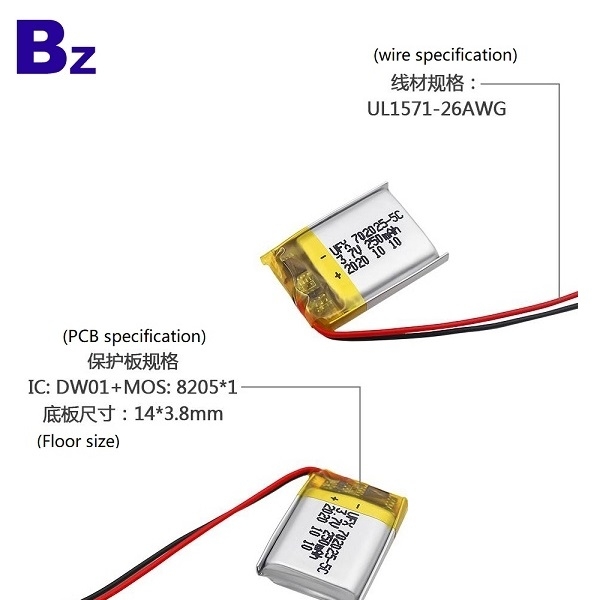1. Types of rechargeable batteries
Nickel-cadmium battery (Ni-Cd)
Voltage: 1.2V
Service life: 500 times
Discharge temperature: -20 degrees to 60 degrees
The charging temperature is: 0 degrees to 45 degrees
Remarks: Strong overcharge resistance.
Ni-MH battery (Ni-MH)
Voltage: 1.2V
Service life: 1000 times
The discharge temperature is: -10 degrees to 45 degrees
The charging temperature is: 10 degrees to 45 degrees
Remarks: The current maximum capacity is about 2100mAh.
Lithium ion battery (Li-lon)
Voltage: 3.6V
Service life: 500 times
Discharge temperature: -20 degrees to 60 degrees
The charging temperature is: 0 degrees to 45 degrees
Remarks: The weight is 30%-40% lighter than Ni-MH batteries, and the capacity is more than 60% higher than Ni-MH batteries. But it is not resistant to overcharging, if overcharging will cause the temperature to be too high and destroy the structure => explosion.

Li-polymer battery (Li-polymer)
Voltage: 3.7V
Service life: 500 times
Discharge temperature: -20 degrees to 60 degrees
The charging temperature is: 0 degrees to 45 degrees
Remarks: The improved type of lithium battery, does not have battery fluid, but instead uses polymer electrolyte, which can be made into various shapes and is more stable than lithium ion batteries.
Lead-acid battery (Sealed)
Voltage: 2V
Service life: 200~300 times
The discharge temperature is: 0 degrees to 45 degrees
The charging temperature is: 0 degrees to 45 degrees
Remarks: It is a general car battery (it is connected in series with 6 2V into 12V). The battery without water can last up to 10 years, but the volume and weight are the largest.
2. Explanation of battery charging performance terms
Charging rate (C-rate)
C is the first letter of Capacity, which is used to indicate the magnitude of the current when the battery is charged and discharged.
For example: when the rated capacity of the rechargeable battery is 1000mAh, it means that the discharge time of 1000mAh (1C) can last for 1 hour. If the discharge time of 200mA (0.2C) can last for 5 hours, the charging can also be calculated according to this comparison.
Cut-off discharge voltage
Refers to the lowest working voltage value when the battery discharges, the voltage drops to the battery no longer suitable for discharging.
According to different battery types and different discharge conditions, the requirements for the capacity and life of the battery are different, so the specified terminal voltage of the battery discharge is also different.
Open circuit voltage (OCV)
When the battery is not discharged, the potential difference between the two poles of the battery is called the open circuit voltage.
The open circuit voltage of a battery will vary depending on the materials of the battery's positive, negative and electrolyte. If the materials of the battery's positive and negative electrodes are exactly the same, the open circuit voltage will be the same regardless of the size of the battery and how the geometric structure changes.
Depth of discharge DOD
In the process of battery use, the percentage of the battery's rated capacity is called the depth of discharge.
The depth of discharge has a deep relationship with the charging life of the secondary battery. When the depth of discharge of the secondary battery is deeper, the charging life will be shorter. Therefore, you should try to prevent deep discharge during use.
Over-discharge
If the battery exceeds the battery discharge termination voltage during the discharge process, the internal pressure of the battery may increase when the battery continues to be discharged, the reversibility of the positive and negative active materials will be damaged, and the battery capacity will be significantly reduced.
Over-charge
When the battery is being charged, after it reaches a fully charged state, if it continues to charge, it may cause the internal pressure of the battery to increase, battery deformation, and night leakage, and the performance of the battery will also be significantly reduced and damaged.
Energy density
The electric energy released by the average unit volume or mass of a battery.
Generally, in the same volume, the energy density of lithium-ion batteries is 2.5 times that of nickel-cadmium batteries and 1.8 times that of nickel-hydrogen batteries. Therefore, when the battery capacity is equal, lithium-ion batteries will be better than nickel-cadmium and nickel-hydrogen batteries. Smaller size and lighter weight.
Self discharge
Regardless of whether the battery is used or not, due to various reasons, it will cause the phenomenon of power loss.
If calculated in a month, the self-discharge of lithium-ion batteries is about 1%-2%, and the self-discharge of nickel-hydrogen batteries is about 3%-5%.
Cycle life
When the rechargeable battery is repeatedly charged and discharged, the battery capacity will gradually drop to 60%-80% of the initial capacity.
Memory effect
In the process of battery charging and discharging, many small bubbles will appear on the battery plate. Over time, these bubbles will reduce the area of the battery plate and indirectly affect the battery capacity.



